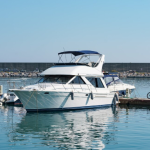Essential Guidelines for Safely Towing Your Sports Bike on UK Motorways: A Comprehensive Guide
Preparing for the Journey: Understanding Your Vehicle and Equipment
Before you embark on towing your sports bike on UK motorways, it’s crucial to ensure that both your towing vehicle and the bike itself are properly prepared. Here are some key points to consider:
Checking Your Towing Vehicle
- Towing Capacity: Make sure your car or van is capable of towing the weight of your sports bike. Check your vehicle’s manual for the maximum towing capacity.
- Towing Equipment: Use a high-quality tow bar and trailer that are specifically designed for towing motorcycles. Ensure all connections are secure and meet UK safety standards.
- Braking System: If you’re using a trailer, it should be equipped with a braking system that is compatible with your vehicle’s brakes.
Securing Your Bike
- Straps and Tie-Downs: Use sturdy straps and tie-downs to secure your bike to the trailer. Make sure the bike is centered and balanced on the trailer.
- Protective Gear: Cover your bike with a protective cover or use padding to prevent scratches and damage during transit.
- Wheel Chocks: Use wheel chocks to prevent the bike from moving around on the trailer.
### Checklist for Preparing Your Vehicle and Bike
- Towing vehicle:
- Check towing capacity
- Ensure proper towing equipment
- Verify braking system compatibility
- Sports bike:
- Secure with straps and tie-downs
- Use protective gear (cover or padding)
- Install wheel chocks
Understanding UK Motorway Rules and Regulations
To ensure a safe and compliant journey, you need to be familiar with the rules and regulations governing motorway use in the UK.
Additional reading : 2023 Guide to UK Sport Bike Helmet Safety Standards: What You Need to Know
Speed Limits and Lane Discipline
- Speed Limits: Be aware of the speed limits on motorways, which are typically 70 mph (113 km/h) unless otherwise indicated. Make sure your speed is adjusted according to the conditions, especially when towing a trailer.
- Lane Discipline: Stay in the right-hand lane unless you need to overtake. When overtaking, use the left-hand lane and return to the right-hand lane once you’ve completed the maneuver.
Road Signs and Traffic Lights
- Road Signs: Pay attention to road signs, especially those related to towing and trailers. Some motorways may have specific restrictions or recommendations for vehicles towing trailers.
- Traffic Lights: When approaching traffic lights or junctions, slow down and prepare to stop. Ensure you have enough space to stop safely, considering the extra length and weight of your trailer.
Interacting with Other Road Users
- Cyclists and Horse Riders: Be cautious of cyclists and horse riders, especially when exiting or entering motorways. Reduce your speed and give them plenty of space.
- Other Vehicles: Be mindful of other vehicles, including cars, trucks, and motorcycles. Maintain a safe distance and avoid sudden maneuvers.
### Key Motorway Rules to Remember
- Speed limits: Typically 70 mph (113 km/h)
- Lane discipline: Stay in the right-hand lane unless overtaking
- Road signs: Pay attention to signs related to towing and trailers
- Traffic lights: Slow down and prepare to stop
- Cyclists and horse riders: Reduce speed and give plenty of space
- Other vehicles: Maintain a safe distance and avoid sudden maneuvers
Safe Towing Practices
Safe towing practices are essential to prevent accidents and ensure a smooth journey.
Loading and Securing the Bike
- Balance and Centering: Ensure the bike is balanced and centered on the trailer to prevent swaying or tipping.
- Tie-Downs: Use multiple tie-downs to secure the bike firmly. Check these regularly during the journey to ensure they remain tight.
Driving Techniques
- Smooth Acceleration and Braking: Avoid sudden acceleration or braking, as this can cause the trailer to sway or the bike to shift.
- Cornering: Take corners slowly and smoothly to maintain stability of the trailer and bike.
- Stopping: Use gentle and gradual braking when stopping, especially in wet or slippery conditions.
Regular Checks
- Pre-Journey Checks: Before starting your journey, check the trailer, tow bar, and bike for any signs of wear or damage.
- During the Journey: Regularly check the tie-downs, trailer lights, and brakes to ensure everything is in good working order.
### Safe Towing Practices Checklist
- Loading and securing the bike:
- Ensure balance and centering
- Use multiple tie-downs
- Driving techniques:
- Smooth acceleration and braking
- Slow and smooth cornering
- Gentle braking
- Regular checks:
- Pre-journey checks (trailer, tow bar, bike)
- Regular checks during the journey (tie-downs, trailer lights, brakes)
Dealing with Emergencies and Breakdowns
Despite careful preparation, emergencies and breakdowns can still occur. Here’s how to handle them:
Also to discover : Exploring the Eco Impact: Riding Sport Bikes in Urban UK – Key Environmental Insights
Emergency Procedures
- Hard Shoulder: If you need to stop, move to the hard shoulder as soon as it is safe to do so. Turn on hazard lights and use warning triangles or flares if available.
- Calling for Help: If you cannot continue driving, call for roadside assistance or emergency services.
Breakdown Checklist
- Safety First: Ensure you and any passengers are in a safe location, away from traffic.
- Assess the Situation: Determine the cause of the breakdown and assess whether it can be fixed on the spot.
- Communication: Inform other road users of the breakdown using warning signs or lights.
### Emergency and Breakdown Procedures
- Moving to the hard shoulder:
- Turn on hazard lights
- Use warning triangles or flares
- Calling for help:
- Roadside assistance
- Emergency services
- Breakdown checklist:
- Ensure safety
- Assess the situation
- Communicate with other road users
Additional Tips for a Smooth Journey
Here are some additional tips to make your journey smoother and safer:
Planning Your Route
- Avoid Peak Hours: Try to avoid peak traffic hours to reduce the risk of congestion and accidents.
- Check Weather Conditions: Plan your route according to weather conditions. Avoid traveling in adverse weather if possible.
Using Technology
- GPS and Navigation: Use GPS and navigation systems to plan the most efficient route and avoid traffic jams.
- Real-Time Traffic Updates: Keep an eye on real-time traffic updates to adjust your route accordingly.
Staying Alert and Comfortable
- Regular Breaks: Take regular breaks to rest and stretch. This helps prevent driver fatigue.
- Comfortable Driving: Ensure your driving position is comfortable and adjust your seat and mirrors accordingly.
### Additional Tips for a Smooth Journey
- Planning your route:
- Avoid peak hours
- Check weather conditions
- Using technology:
- GPS and navigation
- Real-time traffic updates
- Staying alert and comfortable:
- Take regular breaks
- Ensure comfortable driving position
Towing your sports bike on UK motorways requires careful preparation, adherence to rules and regulations, and safe towing practices. By following the guidelines outlined above, you can ensure a safe and smooth journey for both you and other road users.
As a seasoned motorcyclist once said, “The key to safe towing is preparation and attention to detail. Make sure your vehicle and bike are ready, follow the rules of the road, and stay alert during the journey.”
Remember, safety is everyone’s responsibility on the road. By being mindful of your speed, lane discipline, and interactions with other road users, you contribute to a safer environment for all.
### Final Checklist
- Prepare your vehicle and bike
- Understand UK motorway rules and regulations
- Practice safe towing techniques
- Be prepared for emergencies and breakdowns
- Plan your route and use technology to your advantage
- Stay alert and comfortable during the journey
By following these guidelines, you'll be well on your way to a safe and enjoyable towing experience.













